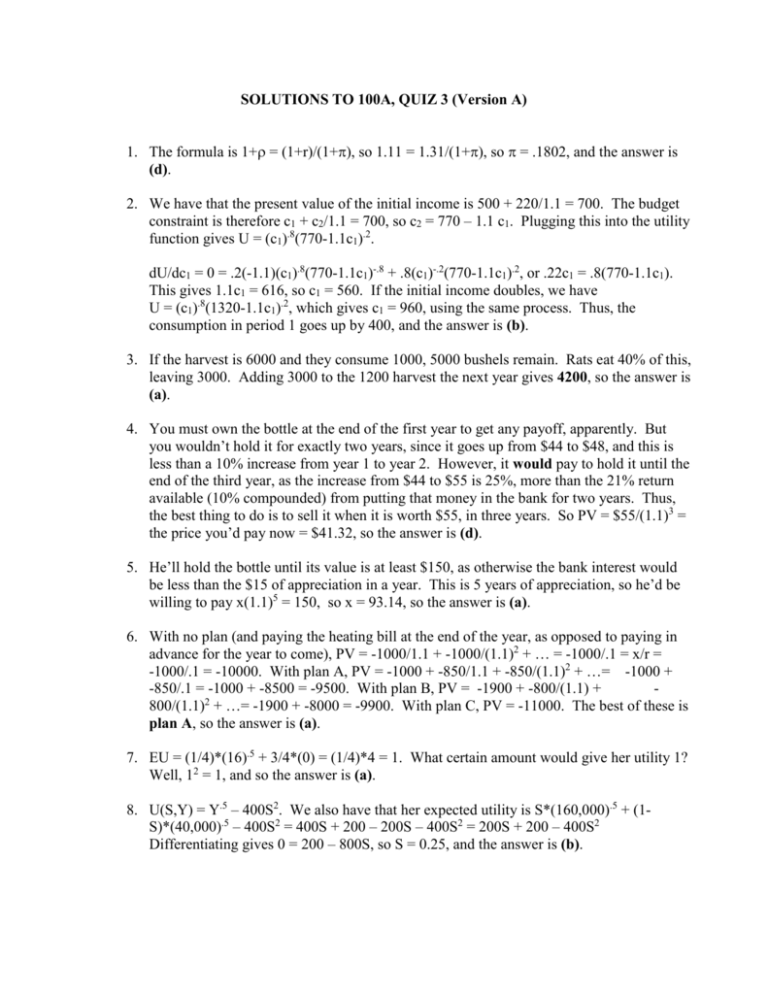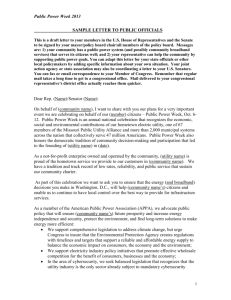SOLUTIONS TO 100A, QUIZ 3
advertisement

SOLUTIONS TO 100A, QUIZ 3 (Version A) 1. The formula is 1+ = (1+r)/(1+), so 1.11 = 1.31/(1+), so = .1802, and the answer is (d). 2. We have that the present value of the initial income is 500 + 220/1.1 = 700. The budget constraint is therefore c1 + c2/1.1 = 700, so c2 = 770 – 1.1 c1. Plugging this into the utility function gives U = (c1).8(770-1.1c1).2. dU/dc1 = 0 = .2(-1.1)(c1).8(770-1.1c1)-.8 + .8(c1)-.2(770-1.1c1).2, or .22c1 = .8(770-1.1c1). This gives 1.1c1 = 616, so c1 = 560. If the initial income doubles, we have U = (c1).8(1320-1.1c1).2, which gives c1 = 960, using the same process. Thus, the consumption in period 1 goes up by 400, and the answer is (b). 3. If the harvest is 6000 and they consume 1000, 5000 bushels remain. Rats eat 40% of this, leaving 3000. Adding 3000 to the 1200 harvest the next year gives 4200, so the answer is (a). 4. You must own the bottle at the end of the first year to get any payoff, apparently. But you wouldn’t hold it for exactly two years, since it goes up from $44 to $48, and this is less than a 10% increase from year 1 to year 2. However, it would pay to hold it until the end of the third year, as the increase from $44 to $55 is 25%, more than the 21% return available (10% compounded) from putting that money in the bank for two years. Thus, the best thing to do is to sell it when it is worth $55, in three years. So PV = $55/(1.1)3 = the price you’d pay now = $41.32, so the answer is (d). 5. He’ll hold the bottle until its value is at least $150, as otherwise the bank interest would be less than the $15 of appreciation in a year. This is 5 years of appreciation, so he’d be willing to pay x(1.1)5 = 150, so x = 93.14, so the answer is (a). 6. With no plan (and paying the heating bill at the end of the year, as opposed to paying in advance for the year to come), PV = -1000/1.1 + -1000/(1.1)2 + … = -1000/.1 = x/r = -1000/.1 = -10000. With plan A, PV = -1000 + -850/1.1 + -850/(1.1)2 + …= -1000 + -850/.1 = -1000 + -8500 = -9500. With plan B, PV = -1900 + -800/(1.1) + 800/(1.1)2 + …= -1900 + -8000 = -9900. With plan C, PV = -11000. The best of these is plan A, so the answer is (a). 7. EU = (1/4)*(16).5 + 3/4*(0) = (1/4)*4 = 1. What certain amount would give her utility 1? Well, 12 = 1, and so the answer is (a). 8. U(S,Y) = Y.5 – 400S2. We also have that her expected utility is S*(160,000).5 + (1S)*(40,000).5 – 400S2 = 400S + 200 – 200S – 400S2 = 200S + 200 – 400S2 Differentiating gives 0 = 200 – 800S, so S = 0.25, and the answer is (b). 9. If he buys $x of insurance, he has to pay $x/6 for it. His expected utility is: (1/11)(5x/6).5 + (10/11)(300,000 – x/6).5. Differentiating gives 0 = .5*(5/6)(1/11)*(5x/6)-.5 - .5(10/11)(-1/6)*(300,000 – x/6)-.5. Simplifying, we have 5*(5x/6)-.5 = 10*(300,000 – x/6)-.5, or WF-.5 = 2*WNF-.5. Squaring both sides gives 1/WF = 4/WNF, or 4WNF = WF, so the answer is (b). 10. Right now he is consuming 200/4 = 50x, so his utility is 2*50 = 100. If he can buy y for $1, he would buy only y, since he gets 1 unit of utility for $1 from consuming y, but only 1 unit of utility for 4/2 = $2 from consuming x. Consuming 100 units of y would give him the same amount of utility as he has currently, so he’d pay up to the amount to join that would leave him with the ability to buy 100y. Since this amount is $100, and he has $200, he’d be willing to pay up to $100 to join the club, and so the answer is (b). 11. If he doesn’t buy a license, he’ll fish for 2 hours, and get utility 43 + 3*2 = 49. If he does buy a license, he’d fish 8 hours, giving him utility of 3*8 = 24 from fishing. He’d need 49 – 24 = $25 in pizza to make him just as well off, so he’d be willing to pay up to $43 $25 = $18 for a license, and so the answer is (a). 12. U(x,m) = 100x – x2/2 + m. But m = 10,000 and the amount he has left over from this is 10,000 – px. So, U(x) = 100x – x2/2 + 10,000 – px. Differentiating gives us 0 = 100 – x – p, so p = 100 – x. This is the inverse demand curve. When p = 50, x = 50, and the consumer surplus is 50*50/2 = 1250. When p = 80, x = 20, and the consumer surplus is 20*20/2 = 200. Thus his consumer surplus falls by 1250 – 200 = 1050 and the answer is (a).








